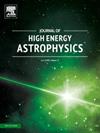利用观测数据集和几何诊断约束f(Q,C)重力中的暗能量演化
IF 10.5
4区 物理与天体物理
Q1 ASTRONOMY & ASTROPHYSICS
引用次数: 0
摘要
我们研究了f(Q,C)=αQ+βC时f(Q,C)引力的宇宙学意义,其中Q是非度规标量,C封装了宇宙膨胀项。利用Hubble、Hubble+BAO和Hubble+BAO+Pantheon数据集,对暗能量EoS的三种参数化ω=ω0+ω1z、ω=ω0+ω1z(1+z)1+z2和ω=ω0+ω1z21+z2进行了测试,以约束模型参数。由此得出的哈勃和减速参数揭示了从减速到加速的转变,支持了目前的宇宙加速观测。对能量密度和压力的分析证实,暗能量的能量密度为正,压力为负,这可能是导致后期加速的原因。我们检查了能源条件,显示符合NEC, WEC和DEC,而SEC仍然是负面的,支持加速扩张。状态检测器诊断表明,两个EoS参数化导致了具有时变暗能量成分的类精粹行为,而第三个接近ΛCDM,显示出与最近观察一致的轻微偏差。声速分析证明了所有参数化的物理稳定性。总的来说,我们的发现支持f(Q,C)引力作为描述各种暗能量动力学的可行框架,为宇宙的加速膨胀提供了见解。本文章由计算机程序翻译,如有差异,请以英文原文为准。
Constraining dark energy evolution in f(Q,C) gravity using observational datasets and geometric diagnostics
We investigate the cosmological implications of gravity with , where Q is the non-metricity scalar and C encapsulates cosmological expansion terms. Three parameterizations of the EoS for dark energy, , and are tested using the Hubble, Hubble+BAO, and Hubble+BAO+Pantheon datasets to constrain model parameters. The resulting Hubble and deceleration parameters reveal a transition from deceleration to acceleration, supporting current cosmic acceleration observations. Analysis of the energy density and pressure confirms positive energy density and a negative pressure for dark energy, potentially driving the late-time acceleration. We examine energy conditions, showing compliance with NEC, WEC and DEC, while SEC remains negative, supporting an accelerated expansion. Statefinder diagnostics suggest that two of the EoS parameterizations lead to Quintessence-like behavior with a time-varying dark energy component, while the third closely approaches ΛCDM showing slight deviations consistent with recent observations. Sound speed analysis demonstrates the physical stability of all parameterizations. Overall, our findings support gravity as a viable framework for describing diverse dark energy dynamics, providing insights into the Universe's accelerated expansion.
求助全文
通过发布文献求助,成功后即可免费获取论文全文。
去求助
来源期刊

Journal of High Energy Astrophysics
Earth and Planetary Sciences-Space and Planetary Science
CiteScore
9.70
自引率
5.30%
发文量
38
审稿时长
65 days
期刊介绍:
The journal welcomes manuscripts on theoretical models, simulations, and observations of highly energetic astrophysical objects both in our Galaxy and beyond. Among those, black holes at all scales, neutron stars, pulsars and their nebula, binaries, novae and supernovae, their remnants, active galaxies, and clusters are just a few examples. The journal will consider research across the whole electromagnetic spectrum, as well as research using various messengers, such as gravitational waves or neutrinos. Effects of high-energy phenomena on cosmology and star-formation, results from dedicated surveys expanding the knowledge of extreme environments, and astrophysical implications of dark matter are also welcomed topics.
 求助内容:
求助内容: 应助结果提醒方式:
应助结果提醒方式:


